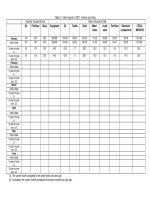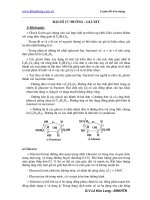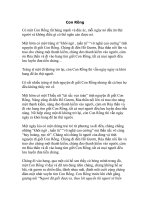Tài liệu Top-Down Design pptx
Bạn đang xem bản rút gọn của tài liệu. Xem và tải ngay bản đầy đủ của tài liệu tại đây (125.56 KB, 16 trang )
CMSC 104, Version 9/01 1
Top-Down Design
Topics
•
Top-Down Design
•
Top-Down Design Examples
•
The Function Concept
Reading
•
Sections 3.9, 3.10
CMSC 104, Version 9/01 2
Top-Down Design
•
If we look at a problem as a whole, it may seem
impossible to solve because it is so complex.
Examples:
o
writing a tax computation program
o
writing a word processor
•
Complex problems can be solved using top-
down design, also known as stepwise
refinement, where
o
We break the problem into parts
o
Then break the parts into parts
o
Soon, each of the parts will be easy to do
CMSC 104, Version 9/01 3
Advantages of Top-Down Design
•
Breaking the problem into parts helps us to
clarify what needs to be done.
•
At each step of refinement, the new parts
become less complicated and, therefore,
easier to figure out.
•
Parts of the solution may turn out to be
reusable.
•
Breaking the problem into parts allows more
than one person to work on the solution.
CMSC 104, Version 9/01 4
An Example of Top-Down Design
•
Problem:
o
We own a home improvement company.
o
We do painting, roofing, and basement
waterproofing.
o
A section of town has recently flooded (zip
code 21222).
o
We want to send out pamphlets to our
customers in that area.
CMSC 104, Version 9/01 5
The Top Level
•
Get the customer list from a file.
•
Sort the list according to zip code.
•
Make a new file of only the customers with the zip
code 21222 from the sorted customer list.
•
Print an envelope for each of these customers.
Main
Sort Select PrintRead
CMSC 104, Version 9/01 6
Another Level?
•
Should any of these steps be broken down
further? Possibly.
•
How do I know? Ask yourself whether or
not you could easily write the algorithm for
the step. If not, break it down again.
•
When you are comfortable with the
breakdown, write the pseudocode for each
of the steps (modules) in the hierarchy.
•
Typically, each module will be coded as a
separate function.









